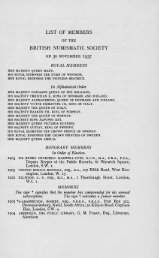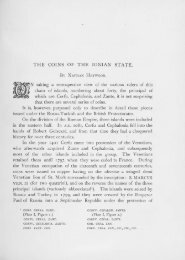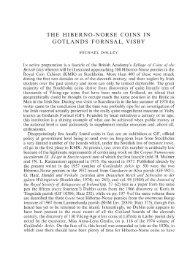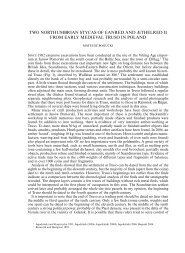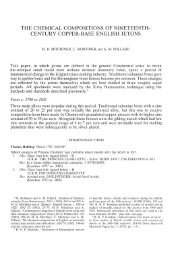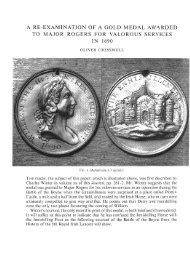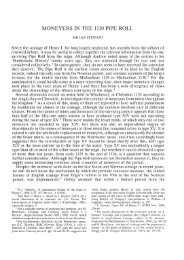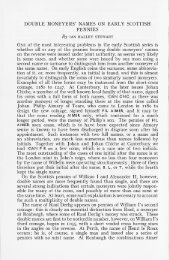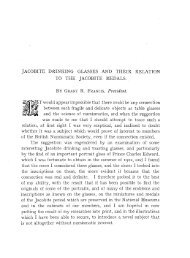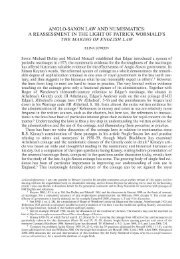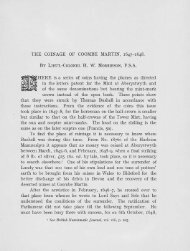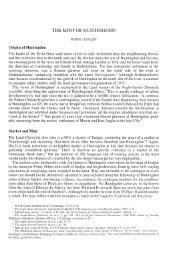Two Anglo-Saxon notes: [1] A Cnut die-link between the mints of ...
Two Anglo-Saxon notes: [1] A Cnut die-link between the mints of ...
Two Anglo-Saxon notes: [1] A Cnut die-link between the mints of ...
You also want an ePaper? Increase the reach of your titles
YUMPU automatically turns print PDFs into web optimized ePapers that Google loves.
TWO ANGLO-SAXON NOTES<br />
R. H. M. DOLLEY<br />
A CNUT DIE-LINK BETWEEN THE MINTS OF SALISBURY AND<br />
WILTON<br />
AT a time when obverse <strong>die</strong>-<strong>link</strong>s <strong>between</strong> late <strong>Saxon</strong> <strong>mints</strong> are attracting a considerable<br />
degree <strong>of</strong> attention, it seems appropriate to put on record an example that seems completely<br />
uncontroversial in so far as one might have expected a moneyer who was working<br />
at two minor <strong>mints</strong> separated by only a few miles occasionally to have transferred an<br />
l 2<br />
FIG. I.<br />
obverse <strong>die</strong> from one establishment to <strong>the</strong> o<strong>the</strong>r. The <strong>die</strong>-<strong>link</strong> in question is <strong>between</strong> <strong>the</strong><br />
<strong>mints</strong> <strong>of</strong> Wilton and <strong>of</strong> Salisbury (Old Sarum), and <strong>the</strong> moneyer is Alfred who is recorded<br />
in <strong>the</strong> 1881 edition <strong>of</strong> Bror Emil Hildebrand's <strong>Anglo</strong>sachsiska Mynt as having<br />
struck at Wilton one solitary coin <strong>of</strong> <strong>Cnut</strong>'s last substantive issue (Hild. 3643). At Salisbury,<br />
on <strong>the</strong> o<strong>the</strong>r hand, ^Elfred is on record for one coin <strong>of</strong> <strong>Cnut</strong>'s first substantive<br />
issue (Hild. 3157), two <strong>of</strong> his last (Hild. 3158/9), and four <strong>of</strong> <strong>the</strong> two successive issues <strong>of</strong><br />
Harold I (Hild. 839-43). The British Museum trays add nothing to this picture, but it<br />
may be noted that <strong>the</strong>re attaches to BMC <strong>Cnut</strong> 559, a <strong>die</strong>-duplicate <strong>of</strong> Hild. <strong>Cnut</strong> 3643,<br />
<strong>the</strong> Wedmore hoard-provenance which is valuable in this context because it virtually<br />
compels acceptance <strong>of</strong> an English origin for <strong>the</strong> <strong>die</strong>s <strong>of</strong> Hild. <strong>Cnut</strong> 3158/9 —pace Hildebrand<br />
from <strong>the</strong> same obverse <strong>die</strong>—and <strong>of</strong> Hild. <strong>Cnut</strong> 3643.
54 TWO ANGLO-SAXON NOTES<br />
The critical <strong>die</strong>-<strong>link</strong> is illustrated by enlarged direct photographs in <strong>the</strong> accompanying<br />
text-block (Fig. 1), Hild. <strong>Cnut</strong> 3158, <strong>the</strong> coin <strong>of</strong> Salisbury, appearing on <strong>the</strong> left, and<br />
Hild. <strong>Cnut</strong> 3643, <strong>the</strong> coin <strong>of</strong> Wilton, on <strong>the</strong> right. The <strong>die</strong>-<strong>link</strong> is particularly clear, and<br />
<strong>the</strong> damage to <strong>the</strong> surface <strong>of</strong> <strong>the</strong> Salisbury coin <strong>of</strong>fers a convincing explanation <strong>of</strong> Hildebrand's<br />
classification <strong>of</strong> <strong>the</strong> legend as 'b' (+CNVT RECX) instead <strong>of</strong> as 'b, ir. 19' (+CNVT<br />
TRECX). This is believed to be <strong>the</strong> first time that an obverse <strong>die</strong>-<strong>link</strong> <strong>between</strong> <strong>mints</strong> has<br />
been published in respect <strong>of</strong> coins <strong>of</strong> <strong>Cnut</strong>'s last substantive issue, and it is to be hoped<br />
that this note will stimulate a systematic search for o<strong>the</strong>rs in a type where <strong>the</strong>re is no<br />
obvious break-down into schools <strong>of</strong> <strong>die</strong>-cutting. It is hard, though, to read any deep<br />
significance into this particular instance. As far as can be judged <strong>the</strong> <strong>die</strong> was used with<br />
<strong>the</strong> two reverses at Salisbury before Wilton, but one should be very reluctant to suppose<br />
<strong>the</strong> iElfred was motivated by anything more than personal convenience. Granted that<br />
Old Sarum was more secure than Wilton, <strong>the</strong>re is not a scrap <strong>of</strong> evidence that Harold's<br />
reign was accompanied by <strong>the</strong> disturbances that would have made security a decisive<br />
factor when a moneyer was planning his operations. Nor is <strong>the</strong>re any reason to suppose<br />
that <strong>the</strong> Old Sarum site was inconvenient for minting purposes in <strong>the</strong> way that <strong>the</strong> sites<br />
at Cadbury and Cissbury undoubtedly were, and in <strong>the</strong> event both Salisbury and Wilton<br />
continued to flourish as <strong>mints</strong> until <strong>the</strong> beginning <strong>of</strong> <strong>the</strong> Plantagenet period. It only<br />
remains for <strong>the</strong> author to express his thanks to Dr. N. L. Rasmusson and Bibliotekarie<br />
L. O. Lagerquist for <strong>the</strong> enlarged photographs that illustrate this note.<br />
A PROBABLE REATTRIBUTION FROM LINCOLN TO<br />
LANGPORT<br />
On p. 401 <strong>of</strong> <strong>the</strong> 1881 edition <strong>of</strong> Bror Emil Hildebrand's <strong>Anglo</strong>sachsiska mynt <strong>the</strong>re<br />
are described as no. 82 a Jewel Cross penny <strong>of</strong> Harthacnut with right-facing bust <strong>of</strong><br />
which <strong>the</strong> reverse legend is read:<br />
+IEGELPINE . . LINC<br />
and as no. 83 a cut halfpenny <strong>of</strong> <strong>the</strong> Arm-and-Sceptre issue <strong>of</strong> <strong>the</strong> same king with reverse<br />
legend:<br />
PINE ON LI . .<br />
Of no. 82 it is remarked that <strong>the</strong> reverse legend is in part indistinct, while no. 83 is assigned<br />
provisionally to ^Egelwine on <strong>the</strong> strength <strong>of</strong> no. 82. In <strong>the</strong> 1932 edition <strong>of</strong> English Coins<br />
G. C. Brooke for once has failed to emulate Hildebrand's caution, and ^Egelwine is<br />
given as a Lincoln moneyer <strong>of</strong> Harthacnut without reserve. The purpose <strong>of</strong> this note is<br />
to suggest that <strong>the</strong> attribution is one that can no longer be maintained.<br />
To take first Hild. Harthacnut 83. That it is a coin <strong>of</strong> Lincoln need not be disputed,<br />
and Mrs. Ulla Westermark has been kind enough to confirm that <strong>the</strong> incomplete <strong>mints</strong>ignature<br />
does in fact read LI . . . What is to be questioned is <strong>the</strong> assumption that <strong>the</strong><br />
missing proto<strong>the</strong>me is yEgel-. In <strong>the</strong> first place -wine is one <strong>of</strong> <strong>the</strong> commonest <strong>of</strong> all<br />
deutero<strong>the</strong>mes where <strong>the</strong> names <strong>of</strong> eleventh-century English moneyers are concerned.<br />
The Stockholm cut halfpenny is to be dated to <strong>the</strong> period 1040-2, and <strong>the</strong> numismatist<br />
can point to a Le<strong>of</strong>wine who was active at Lincoln in <strong>the</strong> period 1035-40 [Hild. Harold<br />
398, 399,404-6, 409 (?), 415,416, &c.] and again in <strong>the</strong> period 1042-8 [Hild. Edw. Conf.<br />
348-55 &c.]. Using '<strong>Cnut</strong>' <strong>die</strong>s he was also active in <strong>the</strong> period 1040-2 [Hild. '<strong>Cnut</strong>'
55 TWO ANGLO-SAXON NOTES<br />
1624-8]. Of his fourteen colleagues who are recorded in Hildebrand as striking c. 1035-<br />
40 and c. 1042-8, only Manna and Swafa are not <strong>the</strong>re listed as moneyers <strong>of</strong> <strong>the</strong><br />
intervening Arm-and-Sceptre issue, while five are known with both ' <strong>Cnut</strong>' and 'Harthacnut'<br />
obverses. It is almost certain, <strong>the</strong>n, that Hild. Harthacnut 83 is a coin <strong>of</strong> <strong>the</strong><br />
moneyer Le<strong>of</strong>wine, and especially if it can once be shown that Hild. Harthacnut 82 has<br />
nothing whatever to do with <strong>the</strong> Lincoln mint.<br />
Hild. 82. Hild. 11.<br />
Fro. 2.<br />
As Fig. 2 <strong>the</strong>re are illustrated side by side Hild. Harthacnut 82 and Hild. Harthacnut<br />
11, a coin <strong>of</strong> <strong>the</strong> moneyer /Egelwine attributed by Hildebrand to Canterbury. It will be<br />
seen at once that <strong>the</strong>y are <strong>die</strong>-duplicates, and that <strong>the</strong> second letter <strong>of</strong> <strong>the</strong> mint-signature<br />
is unquestionably an 'A'. This being so <strong>the</strong>re is no possibility whatever that <strong>the</strong> mint <strong>of</strong><br />
<strong>the</strong> coins could be Lincoln, and forthwith we may expunge <strong>the</strong> name <strong>of</strong> yEgelwine from<br />
<strong>the</strong> roll <strong>of</strong> <strong>the</strong> late <strong>Saxon</strong> moneyers <strong>of</strong> <strong>the</strong> Lincoln mint—<strong>the</strong> yElwine who strikes <strong>the</strong>re<br />
c. 1049 (cf. Hild. Edw. Conf. 286 and 287) is clearly to be equated with /Elfwine (cf.<br />
Hild. Edw. Conf. 283), <strong>the</strong> spelling betraying dissimilation <strong>of</strong> medial 'f' <strong>of</strong> a kind well<br />
attested by <strong>the</strong> coins <strong>of</strong> this period.<br />
There remains <strong>the</strong> question <strong>of</strong> <strong>the</strong> mint to which Hild. Harthacnut 11 and 82 should<br />
be assigned. The first letter <strong>of</strong> <strong>the</strong> mint-signature is clear on none <strong>of</strong> <strong>the</strong> specimens. On<br />
Hild. Harthacnut 11 it could be a square 'c', but, even if it were, Hildebrand's Canterbury<br />
attribution founders. Not only is ^Egelwine (TE<strong>the</strong>lwine) completely unattested as<br />
a Canterbury moneyer <strong>of</strong> <strong>the</strong> late <strong>Saxon</strong> kings—we may note that he is firmly excluded<br />
by Brooke from <strong>the</strong> canon—but <strong>the</strong> spelling CAN would have been impossible for Canterbury<br />
at this period when <strong>the</strong> digraph is invariable, even if CANE had not been utterly<br />
inacceptable on o<strong>the</strong>r grounds. It is noteworthy, though, that on Hild. Harthacnut 82<br />
<strong>the</strong> initial letter has already been read as 'L', and <strong>the</strong>re can be little doubt that this in
56 TWO ANGLO-SAXON NOTES<br />
fact is <strong>the</strong> correct reading. Equally <strong>the</strong> fourth letter <strong>of</strong> <strong>the</strong> mint-signature appears as an<br />
'E' and not a square 'C'. Almost certainly, <strong>the</strong>refore, <strong>the</strong> mint-signature <strong>of</strong> <strong>the</strong> three<br />
coins under discussion is to be reconstructed LANE.<br />
To <strong>the</strong> best <strong>of</strong> <strong>the</strong> writer's knowledge LANE is unattested as a mint-signature in <strong>the</strong> late<br />
<strong>Saxon</strong> period, but <strong>the</strong>re is one obvious emendation. As is well known, square 'E' and<br />
square 'G' were <strong>of</strong>ten confused by <strong>the</strong> engravers, and <strong>the</strong> suggestion <strong>of</strong> this note is that<br />
LANE be emended LANG, and that <strong>the</strong> coins under discussion be given to Langport—in<br />
view <strong>of</strong> <strong>the</strong> rarity <strong>of</strong> coins <strong>of</strong> this mint it should be stressed that only one pair <strong>of</strong> <strong>die</strong>s is<br />
involved. Langport is not recorded in Hildebrand as a Harthacnut mint for <strong>the</strong> period<br />
c. 1035-7, but it is possible to demonstrate that <strong>the</strong> mint was striking at that very<br />
period and that <strong>the</strong> moneyer was an ^Egelwine. Hild. Harold 323 is an undoubted Langport<br />
coin <strong>of</strong> <strong>the</strong> very same issue with mint-signature LA(N)G, and in <strong>Cnut</strong>'s last type, <strong>the</strong><br />
issue immediately preceding <strong>the</strong> joint issue <strong>of</strong> Harold and Harthacnut, <strong>the</strong>re is Lockett<br />
744 with <strong>the</strong> reverse legend reading unequivocally +/EGELPINE ON LAN. TO <strong>the</strong>se coins<br />
we may add Hild. Edw. Conf. 3 with mint-signature LA(N)GEPOR and BMC Edw. Conf.<br />
609 with mint-signature LANGP, and if fur<strong>the</strong>r pro<strong>of</strong> were needed that an yEgelwine was<br />
striking in east Somerset at <strong>the</strong> material time one would have only to cite <strong>the</strong> pattern<br />
<strong>of</strong> iEgelwine coins with <strong>the</strong> mint-signatures <strong>of</strong> Ilchester, Bath, and Bristol. There is,<br />
too, some evidence that Langport and Ilchester were frequented by <strong>the</strong> same moneyers<br />
—it is, for example, inconceivable that <strong>the</strong> Dunberd at Langport, a hapax c. 1041 (Hild.<br />
Harthacnut 72), is not <strong>the</strong> same man as <strong>the</strong> 'Durberd' at Ilchester, a hapax c. 1043<br />
(Hild. Edw. Conf. 174). In <strong>the</strong> Jewel Cross issue itself, moreover, we find coins <strong>of</strong> Harold<br />
by yEgelwine with <strong>the</strong> impeccable mint-signature GIFE and LA(N)G (Hild. 233 and 323<br />
respectively), and on this telling <strong>the</strong> attribution <strong>of</strong> Hild. Harthacnut 11, 82, and 83 to<br />
Langport (LANG) provides <strong>the</strong> perfect foil to Hild. Harthacnut 44 (GIFE).<br />
If <strong>the</strong> above arguments should be found conclusive <strong>the</strong> following emendations are<br />
necessary where <strong>the</strong> 1881 edition <strong>of</strong> <strong>Anglo</strong>sachsiska mynt are concerned:<br />
p. 397 No. 11 The mint is Langport (reads LANE for LANG)<br />
p. 401 No. 82 The mint is Langport (reads LANE for LANG)<br />
No. 83 The moneyer is probably Le<strong>of</strong>wine.<br />
On p. 72 <strong>of</strong> G. C. Brooke's English Coins <strong>the</strong> appropriate entry should begin:<br />
LANGPORT Aegelwine (Cn to Ed)<br />
and Eilwine should be deleted as being no more than a variant spelling, and on p. 73<br />
^Egelwine should be removed from <strong>the</strong> list <strong>of</strong> Lincoln moneyers. It only remains for <strong>the</strong><br />
writer once again to express to <strong>the</strong> authorities <strong>of</strong> <strong>the</strong> Royal Swedish Coin Cabinet his<br />
best thanks for <strong>the</strong> enlarged direct photographs that illustrate this note.


![Two Anglo-Saxon notes: [1] A Cnut die-link between the mints of ...](https://img.yumpu.com/15433998/1/500x640/two-anglo-saxon-notes-1-a-cnut-die-link-between-the-mints-of-.jpg)
